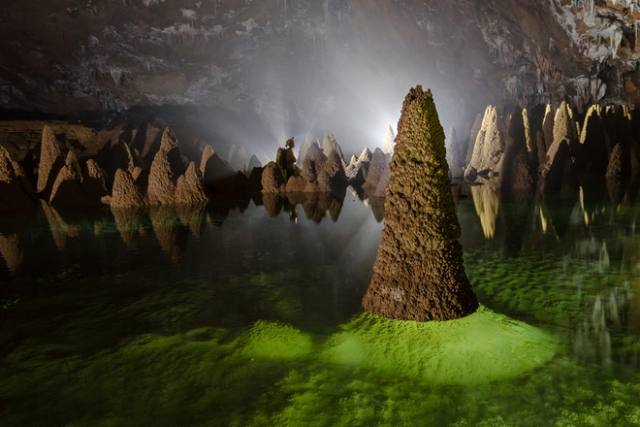Register & Login account by PNKB
Monday, 17/10/2016 - 09:53
Back in time
It is no coincidence that visitors from around the world, who like adventure and discovery, come to Quang Binh province to explore Phong Nha – Ke Bang cave complex. In 1966 the famous French geographer Dr. Pierre Gourou declared this site is the oldest and largest limestone in Southeast Asia and which hides a system of mysterious caves inside here, includes Son Doong – the biggest cave in the world.
Spanning around 200,000 hectares along the national borders of Vietnam and Laos, this limestone complex was formed when the sea bottom rose to create continuous limestone mountains with a thickness of over 1,000 metres. The karst terrain features precipitous serrated and spiky cliffs of hundreds of meters in height. Sandwiched between these cliffs are closed valley sand narrow canyons that span roughly 20 to 100 metres. Sporadic whirlpools in these narrow valleys drew water into submerged rivers to create countless caves of various sizes. The weathering of the karst resulted in magnificent stalactites, stone mushrooms, stone bells and stone pillars that remain intact after hundreds of millions of years in these caves.

The thick lid of this limestone complex is formed by dense flora, like a great hanging garden with diverse plants and habitats. The complex boasts tropical evergreen jungles that grow on limestone mountains and require little or even no soil. The trees' roots sneak into little cracks in the rocks to absorb nutrients, which makes this jungle highly unique in Vietnam and in the world. The most outstanding species is Calocedrus rupestris, an ancient and rare species registered onboth the Vietnamese and global Red List that is found in an area of just 2,400 hectares and is a true miracle of nature. In 2000, the World Wildlife Foundation included Phong Nha in its list of the world's 200 most important biological reserves.
Thanks to the region's rough terrain and dense jungle, few people ventured here, allowing nature to flourish. Even locals who have lived here for generations are wary of the treacherous terrain. As such, IUCN experts believe that undiscovered species remain hidden here.

While explorations on the surface remain challenging, the wonders below ground have ignited a thirst for discovery. Those lucky enough to venture into the caves discover a magical world of crystals scattered by the Creator.
Local lore holds that if you drop a pomelo into a natural spring, it will pop up months later in another spring dozens of kilometres away. Below the Phong Nha – Ke Bang Complex lies an interlacing network of rivers that over the course of hundreds of millions of years have corroded the giant limestone block like a lump of Swiss cheese to form many caves of different sizes. They are connected by a tunnel network that stretches for kilometres.

Research conducted in the caves between 1990 and 2015 has yielded many discoveries and evidence of these caves’ global value. Records include the largest cave mouth in the world – En Cave; the world’s longest submerged cave – Khe Ry Cave; the cave with the largest volume in the world – Son Doong Cave, etc.
Some caves are large enough to accommodate huge rivers that could be sailed by large boats. Others have smooth sandy beaches that could fit hundreds of tents, or sets of stalactites in shapes that ignite our imaginations. Deep holes within these caves contain ancient trees like well-hidden gifts. Each and every turn reveals some fresh magic.
This cave complex is slowly yielding its secrets and allowing explorers to visit places never before seen by humans and view sculptures that no human hand could create./.
Lê Thao
News Column
- 30 of Vietnam’s most beautiful tourist destinations (17/04/2018 16:07:39)
- To respond to world water, meteorological days in 2018 (02/04/2018 09:35:23)
- Wild animal is handed over voluntarily to Center for Rescue, Conservation and Creatures development by a local resident (15/03/2018 15:46:50)
- Responding to the Earth Hour campaign 2018 in Phong Nha – Ke Bang (09/03/2018 13:58:09)
- Getting rare wildlife species to rescue (06/03/2018 15:10:36)
- Phong Nha – Ke Bang National Park celebrated the incense offering memorial and launched New Year tree-planting festival (27/02/2018 14:54:14)
- Visiting Phong Nha – Ke Bang National Park during Tet holiday 2018 (08/02/2018 10:28:23)
- Phong Nha – Ke Bang hold the spring fair in 2018 (30/01/2018 14:54:38)
- 10 prominent events’s Phong Nha – Ke Bang National Park in 2017 (04/01/2018 09:06:08)
- Opening the exhibition on the occasion of New Year 2018 (02/01/2018 15:58:47)
- Phong Nha – Ke Bang National Park Management Board held a conference on deploying the 2018 tasks (02/01/2018 15:35:21)
- Phong Nha – Ke Bang is selected as one of two most experienced destinations in Vietnam by Lonely Planet magazine (21/12/2017 08:23:43)
- Grassroots trade unions of the Emulation Group - Quang Binh Labor Confederation held the summit meeting 2017 and implementation plan 2018 (20/12/2017 15:51:17)
- Quang Binh is listed as one of the top 4 most attractive tourist destinations in Vietnam (08/12/2017 08:34:24)
- The 45th anniversary of the martyrs’heroic sacrifice in Hang Tam Co and Road 20-Quyet Thang (29/11/2017 10:02:18)
- Vietnam’s Cultural Heritage Day (21/11/2017 14:43:05)
- The first international flight of Quang Binh: Dong Hoi-Chiang Mai (21/11/2017 09:04:36)
- Delegation of Khammouane Agriculture and Silviculture Department, Laos PDR works in Phong Nha – Ke Bang National Park (21/11/2017 08:15:54)
- Phong Nha - Ke Bang National Park Management Board celebrated the heroic martyrs' sacrifice at Hang Tam Co and Road 20- Quyet Thang (14/11/2017 13:57:41)
- Tourists to Phong Nha-Ke Bang National Park increase in 2017 (14/11/2017 11:30:13)
Most Viewed News























